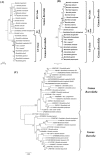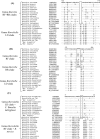Distinction between Borrelia and Borreliella is more robustly supported by molecular and phenotypic characteristics than all other neighbouring prokaryotic genera: Response to Margos' et al. "The genus Borrelia reloaded" (PLoS ONE 13(12): e0208432)
- PMID: 31454394
- PMCID: PMC6711536
- DOI: 10.1371/journal.pone.0221397
Distinction between Borrelia and Borreliella is more robustly supported by molecular and phenotypic characteristics than all other neighbouring prokaryotic genera: Response to Margos' et al. "The genus Borrelia reloaded" (PLoS ONE 13(12): e0208432)
Abstract
In a recent publication in PLOS ONE, Gabriele Margos and colleagues have questioned the division of the genus Borrelia into two genera on the basis that the differences in percentage of conserved proteins (POCP) between these two groups is >50%, which an earlier study has suggested as the threshold for differentiating prokaryotic genera. However, the POCP threshold is a poorly characterized and rarely used criterion for establishing distinction among prokaryotic genera. Detailed evaluation of the intergeneric POCP values for 37 genera from 3 different families (viz. Enterobacteriaceae- 24 genera, Morganellaceae-8 genera and Cystobacteraceae-5 genera) presented here shows that the POCP values for all genera within each of these families exceeded >58%. Thus, the suggested POCP threshold is not a useful criterion for delimitation of genus boundary and the objection by Margos et al. on this ground is invalid. Additionally, Margos et al. have questioned the specificities of ~15-20% of the conserved signature indels (CSIs) described in our work. However, as shown here, this concern is due to misunderstanding of the results and the CSIs in question are still highly-specific characteristics of the members of these genera and they provide important information regarding the evolutionary relationships of two new reptiles-echidna-related species viz. Borrelia turcica and Candidatus Borrelia tachyglossi to other Borrelia species. Results presented here show that both these species are deeper-branching members of the genus Borrelia and their placement within this genus is strongly supported by phylogenetic analyses and multiple uniquely shared CSIs with the other Borrelia species. Based on the large body of evidence derived from phylogenetic, genomic, molecular, phenotypic and clinical features, it is contended that the characteristics clearly distinguishing the Borrelia and Borreliella genera are far more numerous and of different kinds than those discerning most (all) other neighbouring genera of prokaryotes. Thus, the placement of these two groups of microorganisms into distinct genera, Borrelia and Borreliella, which clearly recognizes the differences among them, is highly appropriate and it should lead to a better understanding of the clinical, molecular and biological differences between these two important groups of microbes.
Conflict of interest statement
The author has declared that no competing interests exist.
Figures






Comment on
-
The genus Borrelia reloaded.PLoS One. 2018 Dec 26;13(12):e0208432. doi: 10.1371/journal.pone.0208432. eCollection 2018. PLoS One. 2018. PMID: 30586413 Free PMC article.
References
-
- Wang G, Schwartz I: Genus II. Borrelia Swellengrebel 1907, 582AL In Bergey's Manual of Systematic Bacteriology Volume 4: The Bacteroidetes, Spirochaetes, Tenericutes (Mollicutes), Acidobacteria, Fibrobacteres, Fusobacteria, Dictyoglomi, Gemmatimonadetes, Lentisphaerae, Verrucomicrobia, Chlamydiae, and Planctomycetes. Edited by Brenner DJ, Krieg NR, Garrity GM, Staley JT. New York: Springer Verlag; 2011:484–498.
-
- Barbour AG: Borreliaceae. In Bergey Manual of Systematics of Bacteria and Archaea John Wiley & Sons, Inc. Bergey's Manual Trust; 2019.
Publication types
MeSH terms
Substances
LinkOut - more resources
Full Text Sources
Molecular Biology Databases

